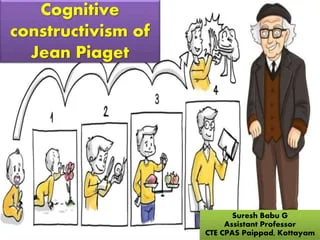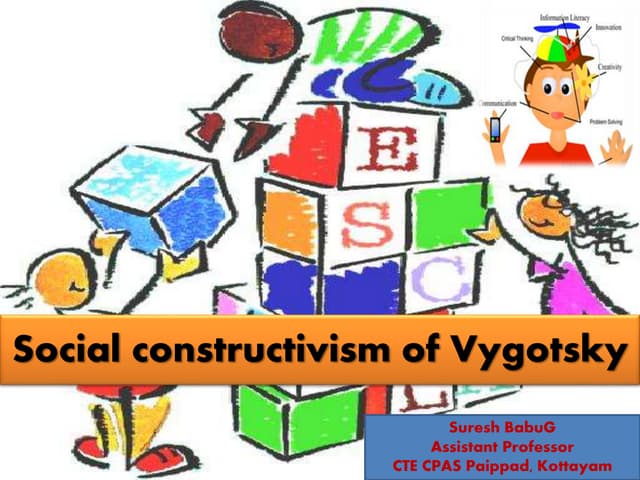Table of Contents
ToggleCONSTRUCTIVISM
Constructivism is a type of learning theory that explains human learning as an active attempt to construct meaning in the world around us
Constructivism divides learning into two types:
- Accommodation.
- Assimilation.
The focus is on the individual’s desire and ability to learn, and the teacher is merely there to help guide self directed learning.
Constructivism is a teaching philosophy based on the concept that learning (cognition) is the result of mental construction. Students construct their own understanding by reflecting on their personal experience, and by relating the new knowledge with what they already know.
Jnassen(1995) defines construction, from the education perspective, as learners producing and constructing their own personal knowledge. He distinguishes this from instructivism whereby the learner is the passive receiver of knowledge, as in the traditional educational model. One of its main principles is that learning is searching for meaning, therefore, to be effective; a teacher must help the student in discovering his or her own meaning.
Characteristics of constructivist learning and teaching
- Teachers serve in the role of guides, monitors, coaches, tutors and facilitators.
- Activities, opportunities, tools and environments are provided to encourage metacognition, self-analysis and self- regulation, self-reflection & reflection self-awareness
- The student plays a central role in mediating and controlling learning.
- Goals and objectives are derived by the student or in negotiation with the teacher or system
- Learning situations environments skills, content and tasks are relevant, realistic and authentic and represent the natural complexities of the real world
- This construction takes place in individual contexts and through social negotiation, collaboration and experience.
- The learne’s previous knowledge constructions, beliefs and attitudes are considered in the knowledge construction process
- Problem Solving, higher order thinking skills and deep understanding are emphasised
- Errors provide the opportunity for insight into student’s previous knowledge construction
- Exploration is a favoured approach in order to encourage students to seek knowledge independently and to manage the pursuit of their goals.
- Learners are provided with the opportunity for apprenticeship learning in which there is an increasing complexity of tasks, skills and knowledge acquisition.
- Scaffolding is facilitated to help students perform just beyond the limits of their ability

Constructivism theorists
Jean Piaget is a Swiss psychologist who began to study human development in the 1920s. His proposed development theory has been widely discussed in both psychology and education fields.
Piaget work has identified four major stages of cognitive growth that emerge from birth to about the age of 14-16. To learn, Piaget stressed the holistic approach. A child constructs understanding through many channels: reading, listening, exploring and experiencing his or her environment.
A child will develop through each of these stages until he or she can reason.
Approximate Age | Stage | Major Development |
Birth to 2 years | sensorimotor | Infants use sensory and motor capabilities to explore and gain understanding of their environment |
2 to 7 years | preoperational | Children begin to use symbols. They respond to objects and events according to how they appear to be |
7 to11 years | Concrete operational | Children begin to think logically |
11 years and beyond | Formal operational | Children begin to think about thinking. Thoughts are systematic and abstract. |
The learner is advanced through three mechanisms.
- Assimilation -fitting a new experience into an mental structure (schema)
- Accommodation – revising an existing schema because of new experience.
- Equilibrium – seeking cognitive stability through assimilation and accommodation.

2. Lev Vygotsky, a Russian psychologist and philosopher in the 1930s, is most often associated with the social constructivist theory. He emphasizes the influences of cultural and social contexts in learning and supports a discovery model of learning
3. Jerome Bruner (1915) is an American psychologist and cultural – interested education. He developed the discovery learning theory, which states some major ideas about learning: Learning is an active social process in which students constructs new ideas or concepts based on current knowledge
His view is: Good methods for structuring knowledge should result in simplifying, generating new propositions, and increasing the manipulation of information. He believes that instruction must be structured so that it can be easily grasped by the student and the instructions should be designed to facilitate extrapolation and or fill in the gaps
Advantages of constructivism
- Students have the opportunity to get directly involved with phenomena and materials. Effective for the learner who does better with hands-on activity. Getting directively involved in the activities helps students relate the information to their own lives.
- Constructivism calls for the eliminations of a standard curriculum, allowing the curricula customised to the student’s prior knowledge
- Allows teachers to focus on what information is truly important. Relieves time constraints to allow teachers spend more time on topics that students show interest in
- Working in groups, learners support each other’s understanding as they articulate their observations, ideas, questions and hypotheses. Working in groups helps students learn social interaction skills they will need later in life. Students will learn to value each other’s input and opinions.
Disadvantages
- Curricula customized to the student’s prior knowledge. All students are going to have different prior knowledge, teachers cannot customize curriculum to every single student
- Constructivism calls for the elimination of grades and standardized testing. Makes it impossible to compare student progressive institution to institution or state to state no reward or goal for student to work towards
- Training that affects student centred teaching cannot come in one day workshops, systematic, long term development that allows practice and reflection on that practice is required

